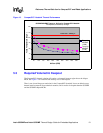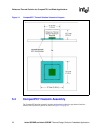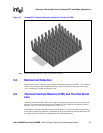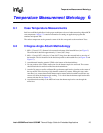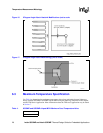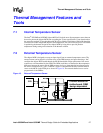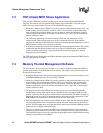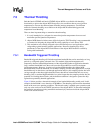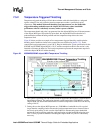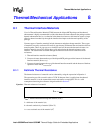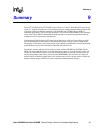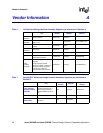
Intel
®
855GME and Intel
®
852GME Thermal Design Guide for Embedded Applications 29
Thermal Management Features and Tools
7.5 Thermal Throttling
Both the Intel
855GME and Intel
852GME chipset MCHs are available with throttling
functionality to protect the chipset MCH from power virus conditions that can cause junction
temperatures to increase beyond maximum allowable junction temperatures. Two different
methods of thermal throttling are available on the chipset MCH: bandwidth triggered and
temperature based throttling.
There are three important things to remember about throttling:
1. It is only intended to be a safeguard to ensure that junction temperatures do not exceed
maximum specified junction temperatures.
2. chipset MCH thermal solutions must still be designed to TDP. Throttling is not recommended
as a method of designing the chipset MCH cooling capability to levels below TDP.
3. This mechanism was carefully designed to have minimal impact on real applications, while
safeguarding against harmful synthetic applications. However, throttling may affect
performance of the chipset MCH. Performance of the chipset MCH should be verified by
testing with benchmarks.
7.5.1 Bandwidth Triggered Throttling
Bandwidth triggered throttling will limit the maximum bandwidth that can be sustained over long
periods as a safeguard against a thermal virus. This method of thermal management will
temporarily decrease bandwidth performance of the chipset MCH when an application demands
large, sustained bandwidth levels that could cause the chipset MCH to exceed its maximum
junction temperature. However, in order to trigger bandwidth throttling, the chipset MCH
bandwidth must exceed the threshold over an entire sampling window. Most applications use high
bandwidths only in short bursts, and through application analysis, this sampling window has been
set large enough so that these applications that create short bursts in bandwidth will not see any
throttling. Only a sustained high bandwidth for a period longer than the sampling window has the
potential of exceeding thermal limits, and the throttle mechanism is designed to protect the chip
against those potentially harmful applications.
Figure 19 below provides a theoretical example of how bandwidth throttling would work. In this
example, the bandwidth is set to throttle at 1100 MB/sec. The throttling value would be determined
based on the worst case operating conditions. This throttle setting is enabled upon system boot and
only one value can be set for the WRITE operations of the chipset MCH. To determine bandwidth,
the read/write operations are being monitored continuously by hardware inside the chipset MCH
within a one second window.



